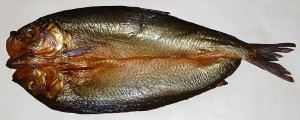A kipper is a whole herring that has been split butterfly fashion from tail to head along the dorsal ridge, gutted, salted or pickled, and cold smoked over smouldering woodchips (typically oak).
The word kipper could have its origins in the old English ‘kippian’ to spawn, ‘kipe’ a basket to catch fish or even another theory which traces the word back to ‘kip’ the small beak developed by male salmon in the breeding season.
In any case the word is very old, as is the idea of preserving fish by smoking, much older than any more recent claims for the discovery of the process, usually by accident. For instance Thomas Nashe wrote in 1599 about a fisherman from Great Yarmouth who discovered smoking herring by accident and another story of the accidental invention of kipper is set in 1843, with John Woodger of Seahouses, Northumberland who left fish for processing overnight in a room with a smoking stove.
A kipper is also sometimes referred to as a red herring, although particularly strong curing is required to produce a truly red kipper. The term appears in a mid 13th century poem ‘He eteþ no ffyssh But heryng red’ and later Samuel Pepys recorded in his diary entry of 28 February 1660 ‘up in the morning, and had some red herrings to our breakfast, while my boot-heel was a-mending, by the same token the boy left the hole as big as it was before’. Kipper kedgeree appeared on victorian breakfast tables and kippers were frequently a high tea or supper treat in the first half of the 20th century.
The dyeing of kippers was introduced as an economy measure in WW1 so reducing the smoking time and allowing them to be sold quickly, easily and for a substantially greater profit. Kippers were originally dyed using a coal tar dye called Brown FK (abbreviation of “For Kippers”) but today, kippers are usually brine dyed using a natural annoto dye, giving the fish a deeper orange/yellow colour. However kippers from the Isle of Man are not dyed and the smoking time is extended in the traditional manner. Thousands are produced annually in Peel, where there are two kipper houses, Moore’s Kipper Yard (founded 1882) and Devereau and Son (founded 1884). The Manx word for kipper is skeddan jiarg, literally translated this is ‘red herring’.
Delia Smith says ‘Look for plumpness, oiliness, a silvery golden colour and a good smoky smell in a kipper. All fish tastes better cooked on the bone, and kippers are no exception.’ You can bake kippers in a hot oven and grilling is very good although others will swear that the only method is to ‘jug’ them in boiling water and serve with a knob of butter. Both kippers and herrings taste especially good cooked on a barbecue out in the open air and then there’s no problem for smell. Or why not try a kedgeree – delicious.
